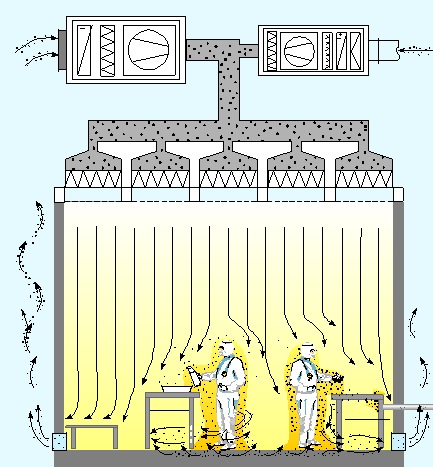
We use laminar flow technology in our clean room environment.
A clean room is commonly heard with regards to data recovery. A clean room doesn’t mean you just vacuumed and dusted, or picked up your old socks off the floor; it is a vital component for any company who is a serious provider of data recovery services. The internal components of a hard drive have very little tolerance for dust contamination. Therefore when an inspection needs to be done, or work performed on the inside of a hard drive, then it needs to be done in a Class-100 or better clean room. At ACS Data Recovery, we utilize a Class-00 Laminar Flow system, and this is more than adequate for working on hard drives.
In general a cleanroom is an environment, typically used in manufacturing or scientific research, that has a low level of environmental pollutants such as dust, airborne microbes, aerosol particles and chemical vapors. More accurately, a cleanroom has a controlled level of contamination that is specified by the number of particles per cubic meter at a specified particle size. To give perspective, the ambient air outside in a typical urban environment might contain as many as 35,000,000 particles per cubic meter, 0.5 µm and larger in diameter, corresponding to an ISO 9 cleanroom.
Cleanrooms can be very large. Entire manufacturing facilities can be contained within a cleanroom with factory floors covering thousands of square meters. They are used extensively in semiconductor manufacturing, biotechnology, the life sciences and other fields that are very sensitive to environmental contamination.
The air entering a cleanroom from outside is filtered to exclude dust, and the air inside is constantly recirculated through high efficiency particulate air (HEPA) and ultra low penetration air (ULPA) filters to remove internally generated contaminants.
In some cases staff enter and leave through airlocks (sometimes including an air shower stage), and wear protective clothing such as hats, face masks, gloves, boots and cover-alls.
Equipment inside the cleanroom is designed to generate minimal air contamination. There are even specialised mops and buckets. Cleanroom furniture is also designed to produce a minimum of particles and to be easy to clean.
Common materials such as paper, pencils, and fabrics made from natural fibers are often excluded; however, alternatives are available. Cleanrooms are not sterile (i.e., free of uncontrolled microbes)[1] and more attention is given to airborne particles. Particle levels are usually tested using a particle counter.
Some cleanrooms are kept at a positive pressure so that if there are any leaks, air leaks out of the chamber instead of unfiltered air coming in.
Some cleanroom HVAC systems control the humidity to relatively low levels, such that extra precautions are necessary to prevent electrostatic discharge (ESD) problems. These ESD controls (“ionizers”) are also used in rooms where ESD sensitive products are produced or handled.
Low-level cleanrooms may only require special shoes, ones with completely smooth soles that do not track in dust or dirt. However, shoe bottoms must not create slipping hazards (safety always takes precedence). Entering a cleanroom usually requires wearing a cleanroom suit.
In cheaper cleanrooms, in which the standards of air contamination are less rigorous, the entrance to the cleanroom may not have an air shower. There is an anteroom, in which the special suits must be put on, but then a person can walk in directly to the room.
Cleanrooms are classified according to the number and size of particles permitted per volume of air. Large numbers like “class 100” or “class 1000” refer to US FED STD 209E, and denote the number of particles of size 0.5 µm or larger permitted per cubic foot of air. The standard also allows interpolation, so it is possible to describe e.g. “class 2000”.
Small numbers refer to ISO 14644-1 standards, which specify the decimal logarithm of the number of particles 0.1 µm or larger permitted per cubic metre of air. So, for example, an ISO class 5 cleanroom has at most 105 = 100,000 particles per m³.
Both FS 209E and ISO 14644-1 assume log-log relationships between particle size and particle concentration. For that reason, there is no such thing as a “zero” particle concentration. The table locations without entries are N/A (“not applicable”) combinations of particle sizes and cleanliness classes, and should not be read as zero.
Because 1 m³ is approximately 35 ft³, the two standards are mostly equivalent when measuring 0.5 µm particles, although the testing standards differ. Ordinary room air is approximately class 1,000,000 or ISO 9.


